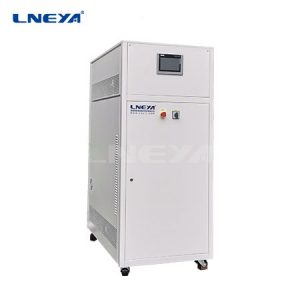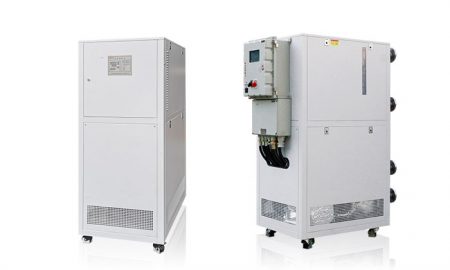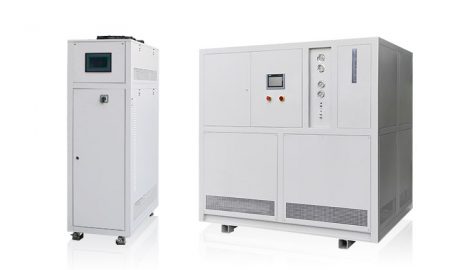Heated Circulating Baths
Heated circulating baths are a type of heating equipment widely used in chemical, pharmaceutical, food, light industry and other industries. Its main function is to heat liquids and circulate them in pipelines to meet the needs of heating or heat preservation.
Principle of heated circulating baths
The working principle of heated circulating baths is to circulate and heat liquid through pipelines, and then re-transport the heated liquid to the equipment that needs to be heated. Specifically, a circulator usually consists of a heater, circulation pump, pipes, and control system. When the circulator is started, the heater heats the liquid to the set temperature, and then the circulation pump circulates the heated liquid through the pipeline to the equipment that needs to be heated. When the temperature of the liquid drops, the control system will automatically start the heater to heat the liquid to the set temperature again to ensure that the liquid is always within the set temperature range.

Structure of heated circulating baths
The structure of heated circulating baths mainly consists of heaters, circulating pumps, pipelines, control systems and other parts. Among them, the heater usually uses electric heating, steam heating, thermal oil heating, etc. for heating, and the circulation pump is responsible for circulating the heated liquid to the equipment that needs to be heated. Pipes are the channels that connect the heater and the circulation pump, and are generally made of stainless steel, copper and other materials. The control system is used to control the start and stop of the heater and the adjustment of the liquid temperature, usually using a PLC or PID controller.
Characteristics of heated circulating baths
High precision: heated circulating baths use advanced temperature control technology to achieve high-precision control of liquid temperature, with an accuracy of ±1°C.
Energy saving and environmental protection: heated circulating baths adopt high-temperature circulating heating method, which can effectively save energy, reduce heat energy loss, and avoid liquid waste and pollution.
Easy to operate: heated circulating baths are easy to operate and can be operated through the touch screen or buttons. The control system automatically adjusts the heater’s.

The workflow of heated circulating baths is as follows:
Startup: First pour liquid into the liquid storage tank and ensure that the liquid level is within the normal range. Then start the heated circulating baths to start the circulation pump.
Heating: The heater starts working, converts electrical energy or fuel energy into thermal energy, and heats the liquid. The circulation pump draws the heated liquid from the liquid storage tank and delivers it to the heating system through the pipeline.
Circulation: The heating liquid circulates in the heating system and transfers heat to the equipment or process that needs to be heated through the pressure delivery of the circulation pump. At the same time, the cooling system can circulate the coolant to the heating system to keep the temperature of the circulating fluid stable.
Control: The control system monitors the temperature, pressure, flow and other parameters of the heating liquid in real time, and controls and adjusts it according to the set requirements.
Correo electrónico: info@lneya.com WeChat ID: +8615251628237 WhatsApp: +86 17851209193

Termostatos de circulación
Rango de control de temperatura: +50°C a +300°C
Nota: La serie UC puede controlar la temperatura del medio de transferencia de calor. La serie UST no solo puede controlar la temperatura del medio de transferencia de calor, sino también la temperatura del material de reacción.
| Temperatura | +50°C ~ +170°C (serie UC) | +50°C ~ +300°C (serie UC) | +50°C ~ +300°C (serie UST) | ||||||
| Capacidad de calefacción | 5,5 ~ 15 kW | 3,5 ~ 130 kW | 3,5 ~ 95 kW | ||||||
| Nota: Se puede personalizar cualquier rango de temperatura de -150℃ ~ +350℃ y cualquier capacidad de refrigeración. | |||||||||

Sistemas de refrigeración y calefacción (serie SUNDI)
Rango de control de temperatura: -120°C a +350°C
termostato de refrigeración y calefacción, ampliamente utilizado en diversas industrias.
| Temperatura | Serie -10 ~ +150°C | Serie -25 ~ +200°C | Serie -25 ~ +300°C | Serie -45 ~ +250°C | Serie -45 ~ +300°C | Serie -60 ~ +250°C | Serie -60 ~ +300°C | Serie -70 ~ +250°C | Serie -80 ~ +250°C | Serie -90 ~ +250°C | Serie -100 ~ +100°C | ||
| Capacidad de refrigeración | 1,5 ~ 15 kW | 1 ~ 200 kW | 1 ~ 200 kW | 0,45 ~ 200 kW | 0,9 ~ 25 kW | 0,25 ~ 60 kW | 0,75 ~ 25 kW | 0,4 ~ 15 kW | 0,3 ~ 80 kW | 0,2 ~ 80 kW | 0,45 ~ 80 kW | ||
| Nota: Se puede personalizar cualquier rango de temperatura de -150℃ ~ +350℃ y cualquier capacidad de refrigeración. | |||||||||||||

Sistemas de refrigeración y calefacción (serie WTD)
(Microcanales / reactores tubulares especializados)
Rango de control de temperatura: de -70°C a +300°C
Diseño especializado para microcanal (pequeña capacidad de retención de líquido, gran capacidad de intercambio de calor, sistema de circulación de alta caída de presión)
| Temperatura | -70°C ~ +300°C | -45°C ~ +250°C | -70°C ~ +200°C | ||||||
| Capacidad de refrigeración | 1,1 ~ 7,5 kW | 1,5 ~ 5,5 kW | 11 ~ 50kW | ||||||
| Nota: Se puede personalizar cualquier rango de temperatura de -150℃ ~ +350℃ y cualquier capacidad de refrigeración. | |||||||||

Circuladores de refrigeración y calefacción
Rango de control de temperatura: -45°C a +250°C
| Temperatura | Serie -25°C ~ +200°C | Serie -45°C ~ +250°C | |||||||
| Capacidad de refrigeración | 1 ~ 15 kW | 0,25 ~ 15 kW | |||||||
| Nota: Se puede personalizar cualquier rango de temperatura de -150℃ ~ +350℃ y cualquier capacidad de refrigeración. | |||||||||
 LNEYA
LNEYA
 简体中文
简体中文

















































































